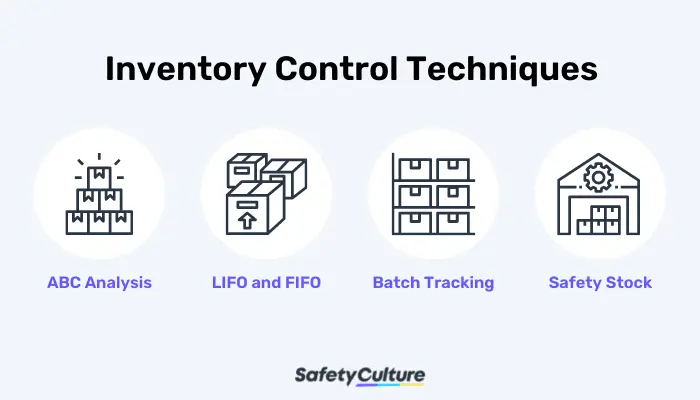What is Inventory Control?
Also called stock control, inventory control consists of systems and procedures for managing inventory items in a company’s warehouse. It monitors the movement and storage of goods in a warehouse to help businesses maintain a sufficient supply in good condition. Establishing an inventory control system enables them to satisfy customer demands and maximize profits.
Inventory control is a key element of an inventory management system. Warehouse managers and production planners should adhere to the following activities and procedures in controlling their inventory:
- Receiving, storing, and transferring goods
- Placing items in strategic locations
- Tracking inventory items and their locations in the warehouse
- Documenting product details and histories
- Monitoring the condition of items in stock
- Fulfilling purchase orders with stock on hand
- Integrating barcode scanners
- Forming reorder reports
Difference Between Inventory Control and Inventory Management
Although these two concepts go hand in hand, there are slight differences between inventory control and inventory management. Inventory control handles existing stock in a warehouse, while inventory management involves the overall movement of goods across supply chains.
The table below compares the two processes against their scope, goal, areas of concern, and actions.
| Inventory Control | Inventory Management | |
| Scope | Existing inventory in the warehouse | Raw materials and finished goods during the entire production lifecycle |
| Goal | Ensuring stocks in the warehouse are enough and in good condition | Having the right inventory in the right place, at the right time, and with sufficient quantity |
| Areas of Concern |
|
|
| Actions |
|
|
Types of Inventory Control Systems
There are two main types of inventory control systems: the periodic and the perpetual system. Choosing the right inventory control system will depend on the business type, size, and kind of inventory. This section discusses these two types in detail, covering their pros and cons, as well as what they’re best for.
Periodic Inventory Control System
The periodic inventory control system pertains to a recurring count of goods at specific intervals. In this system, warehouse managers manually count their inventory on a monthly, quarterly, or annual basis. The exact period depends on an organization’s needs and business activities.
Pros: It’s relatively simple and easy to manage for smaller inventories. It doesn’t require any specialized technology and equipment, making it easier to train individuals in.
Cons: It becomes a lengthy process for companies with expansive inventories. The manual counting process is also highly prone to human error.
Best for: The periodic system is ideal for small companies with minimal inventory. It also works best for businesses selling niche products and counting larger-sized goods.
Perpetual Inventory Control System
The perpetual inventory control system provides an accurate count of inventory levels in real-time. It utilizes technology, such as barcodes and Radio Frequency Identification (RFID) tags, for tracking products. The information is then logged in a centralized database that warehouse managers can easily access.
Pros: This method removes the need for manual counting. It gives warehouse managers a snapshot of their inventory counts over a specific period of time. Doing so drives data-driven decision-making for sales, ordering, and inventory management.
Cons: An inventory control software can be expensive to maintain. Moreover, it might not capture discrepancies due to product theft, loss, damage, and scanning errors.
Best for: The perpetual system works best for companies with multiple locations. It’s also great for businesses maintaining large inventories.
Inventory Control Techniques
Inventory control involves various techniques for monitoring how stocks move in a warehouse. Four popular inventory control methods include ABC analysis; Last In, First Out (LIFO) and First In, First Out (FIFO); batch tracking; and safety stock. This section explains how each of these methods functions and how they can support your business.

Inventory Control Techniques | SafetyCulture
ABC Analysis
ABC analysis in inventory control classifies stocks based on their importance, price, and sales volume. These criteria determine the number of items a company will bring to the market.
Just as its name suggests, it consists of the following categories:
- A class – expensive, high-class items with tight controls and small inventories
- B class – average-priced, mid-priority items with medium sales volume and stocks
- C class – low-value, low-cost items with high sales and huge inventories
Applying the ABC analysis of inventory control allows businesses to minimize the costs of carrying products while maximizing their stock returns.
LIFO and FIFO
Both inventory control techniques organize how inventory items move in and out of the warehouse based on their arrival date. Priority will depend on the type of products available in the storage facility.
Using the LIFO method, the warehouse puts out the most recent batch of items to the customers first. Doing so prevents products from going bad when delivered to the market.
But with the FIFO technique, the warehouse prioritizes older stocks for processing and shipping. This way, they can keep the products fresh when the customer receives them.
Batch Tracking
Batch tracking is also a great way of organizing stock items in a warehouse facility. In this method, goods of the same production date and materials are grouped together. Doing this helps warehouse managers keep track of the following information:
- Where the items come from
- Where the goods are heading
- When the items might expire
Safety Stock
Safety stock involves having an additional set of goods on hand as a preventive measure for the market’s volatility. The amount should be over the average demand or use of the product.
It acts as a safety net, should customer demand go above the projected amount. It also covers them for any uncertainty in supply performance, such as shipping delays.
Tips on Getting Started
After discussing the types and techniques employed in an inventory control system, it’s time to put those measures into practice. Here are some tips to help you kickstart your inventory control process.
- Start with an inventory control plan – This plan should address the movement of goods from production to sales and removal from the inventory database.
- Put it into practice – Carrying out the inventory control plan includes establishing metrics and forecasts for succeeding months. You can also adjust your stock management strategy as needed.
- Consistency is key in labeling products – Find a system that works for your company and stick to it. Consider looking into barcodes, RFIDs, and Stock Keeping Units (SKUs).
- Establish reorder points – This practice systematically replenishes your stock items at set periods so you can take better control of your lead time. The ABC analysis method is a helpful tool for carrying this out.
- Always keep critical items in stock – Identify which goods are critical for your business and ensure they never go out of stock.
- Review product shipments – Read over the packing slips and check products for any damage to prevent inventory loss.
- Perform warehouse audits regularly – Warehouse personnel can run through their stocks for spoilage, theft, and potential human errors. Doing so ensures that the accounting team receives accurate information about the counts and costs of your inventory. It’s best to use a digital inventory checklist to simplify this process.
Explore our Free Inventory Templates
See how digital checklists simplify business processes with just a tap.
View nowHow Training Can Help You Implement Best Practices
Apart from having clear and comprehensive operational manuals for inventory control in place, it’s vital that they’re effectively communicated to your workers. This is where the need for training comes in.
With good inventory control training, you can effectively reinforce the best practices outlined in your operating manuals and Standard Operating Procedures (SOPs). And on top of higher quality work and better productivity, it can also help your workers become more aware of potential issues and more proactive in preventing mishaps along the way.
Say goodbye to the days of boring training and operating manuals. With SafetyCulture (formerly iAuditor)’s Training feature, you can easily transform your work instructions into training slides that are interactive, visually appealing, and easy to understand.
But that’s not all – you can also make this training accessible to your team using their preferred devices. And with SafetyCulture Training’s offline access, they can brush up on their skills even without an internet connection.




